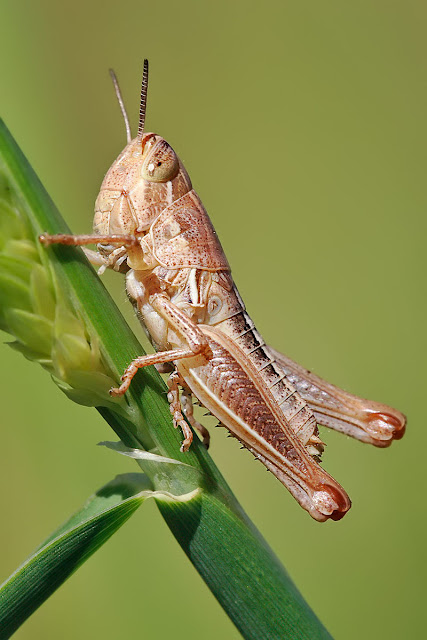Grasshopper Facts
Grasshopper Facts
Image Source: "Young grasshopper on grass stalk02". Licensed under GFDL 1.2 via Commons https://commons.wikimedia.org/wiki/File:Young_grasshopper_on_grass_stalk02.jpg#/media/File:Young_grasshopper_on_grass_stalk02.jpg
everywhere except the North and South Poles. And even though they’re common, they’re also quite fascinating.
2. Lubber grasshoppers are large, colorful, and usually bear short wings. The shape of the head, though variable, is usually broadly rounded. The hind femora are enlarged. When disturbed, lubber grasshoppers may hiss and spread their wings. Both the front wings and hind wings are brightly colored.
3. There are 18,000 different kinds of grasshoppers in the world.
4. Grasshoppers are herbivores.
5. Grasshoppers go through incomplete metamorphosis
6. Grasshoppers have no ears. They hear with an organ called tympanum.
7. Most types of grasshoppers have two pairs of wings.
8. Grasshoppers have five eyes.
9. Some grasshoppers rub their wings together to create music, others snap their wings together while flying, and others just rub their hind legs across their front wings.
10. A Grasshopper is an amazing insect that can leap 20 times the length of its own body. If you or I could do that, we would be able to jump almost 40 yards!
11. Grasshoppers can be found almost everywhere in the world, except for the colder regions near the North and South poles.
12. They live in fields, meadows, and just about anywhere they can find generous amounts of leaves to eat. Some types of grasshoppers will only eat certain types of plants. Others will eat any type of plant they can find.
13. Grasshoppers can destroy entire crops of alfalfa, clover, cotton, corn and other grains, causing millions of dollars in crop damages every year.
14. When a grasshopper is picked up, they “spit” a brown liquid which is known by most kids and adults as “tobacco juice.” Some scientists believe that this liquid may protect grasshoppers from attacks by insects such as ants.
15. The gaudy grasshopper is named after explorer Ludwig Leichhardt, who reported great numbers of them as he crossed Australia’s remote Arnhem Land plateau in 1845. However, a few years later, Leichhardt’s Grasshopper mysteriously disappeared and was gone for 125 years. It didn’t come back until 1973!


Interesting facts! Very useful.
ReplyDeletenot interesting facts not useful
ReplyDelete